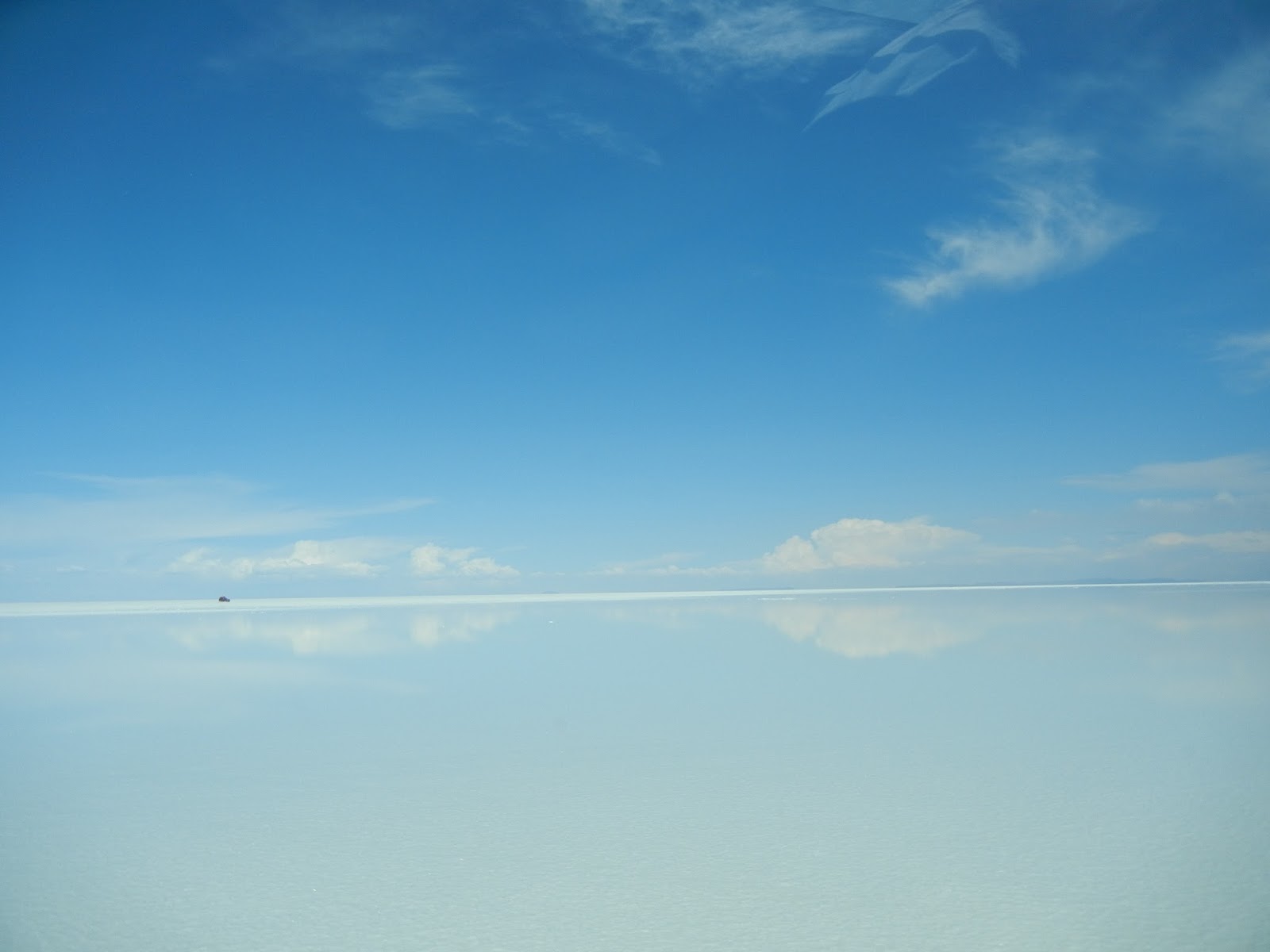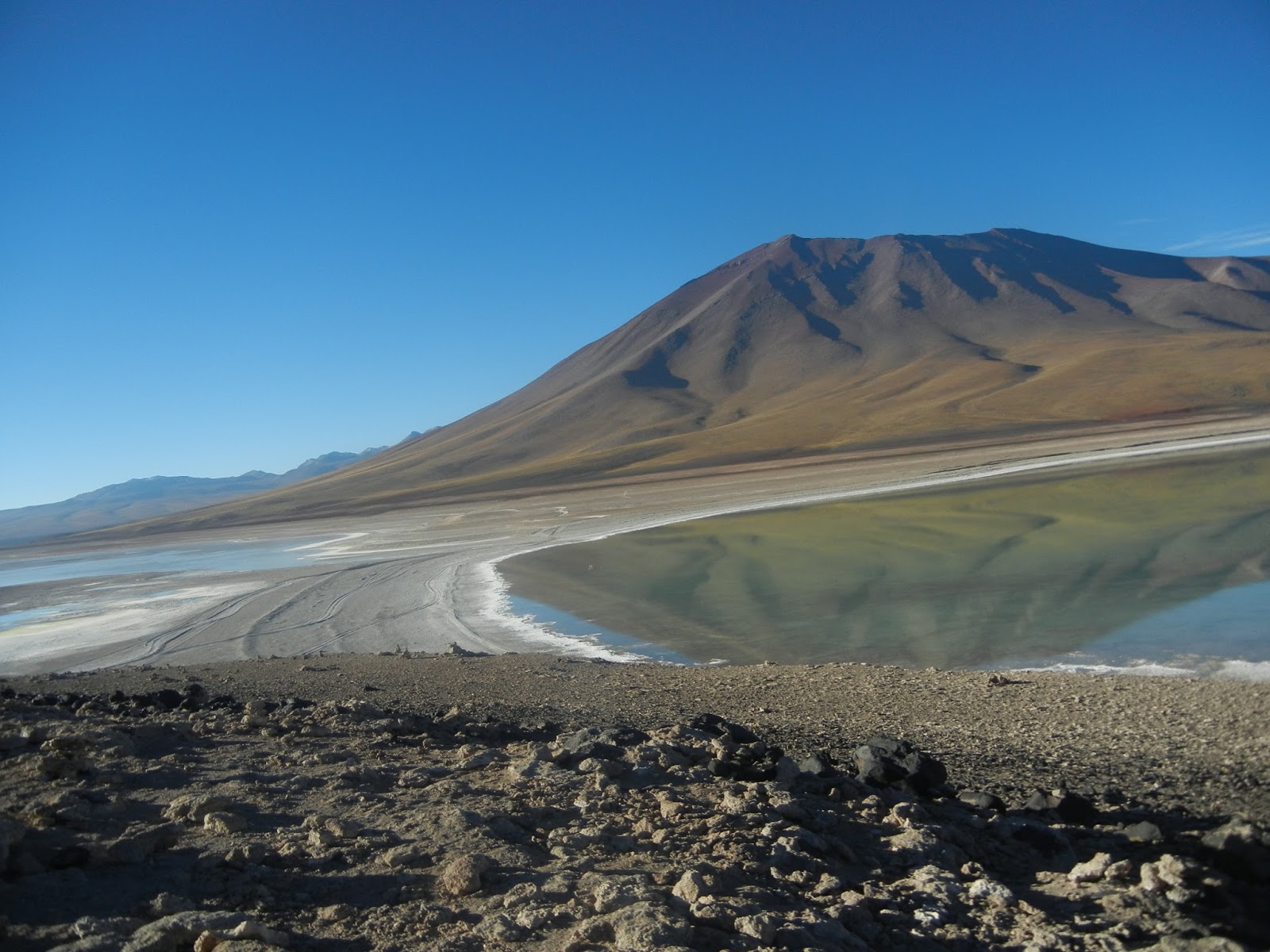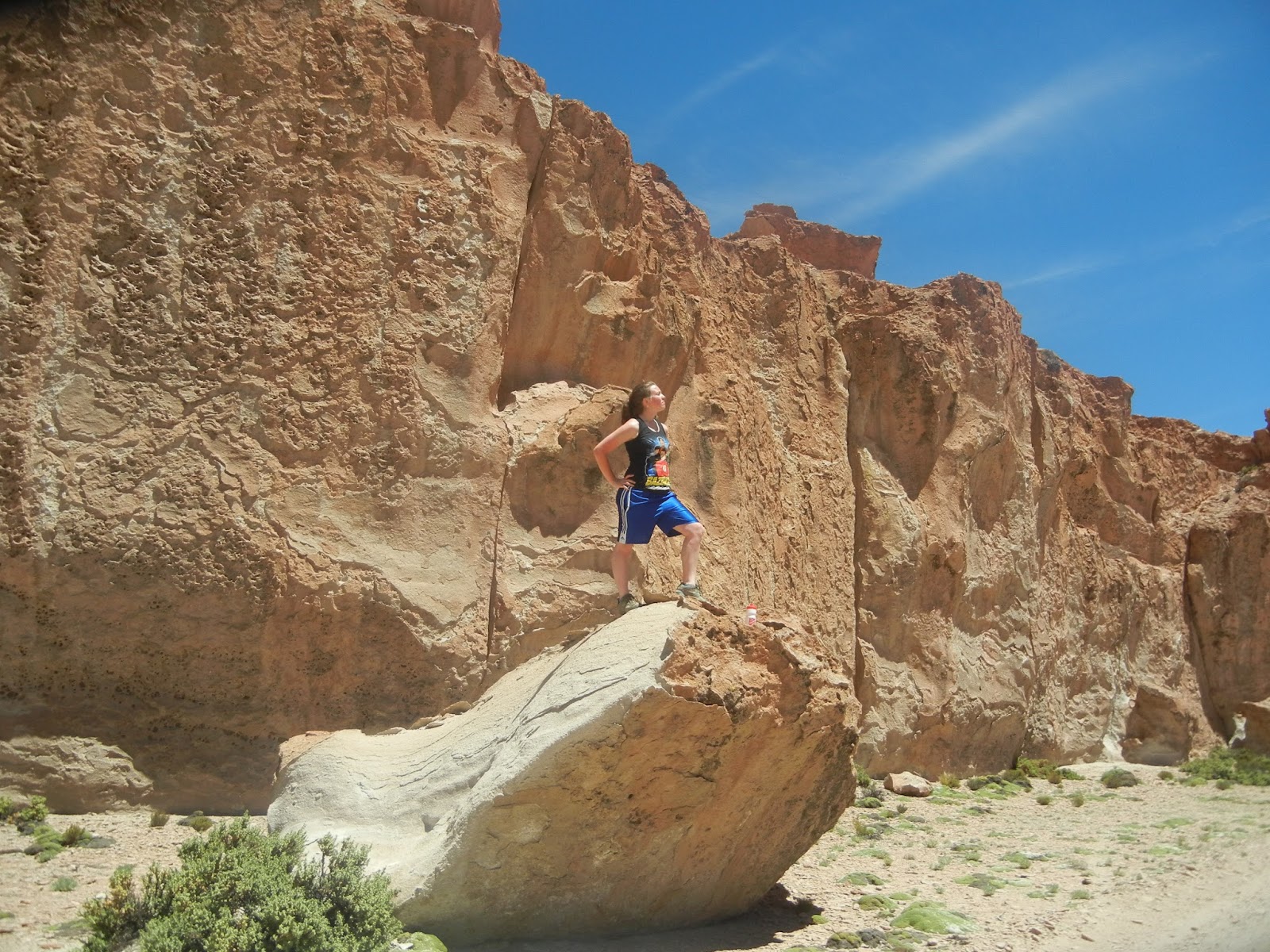The bus rolled in at 9:30 am. We got directions to our
travel agency’s office and walked there. We found out that we were leaving for
our tour in an hour. We hurried to take out some more Bolivianos and to eat a
quick meal before we left.
The time flew by and before we knew it, we were loading up the Jeep and hopping in. After the 3 of us got in the Jeep, 3 more travelers followed. We quickly learned that they were from France. Alejandro, our tour guide, hopped into the driver’s seat, made introductions, and just like that we were off. Our fellow travelers were very interesting individuals. Clamont and Naomi spoke nearly fluent Spanish. Clamont knew hardly any English but Naomi was very proficient. The guy, Charles, spoke nearly fluent English and hardly in Spanish. Alex speaks a little French and we all speak some Spanish. We used quite the smorgasbord of languages to communicate and depending on our linguistic needs, we talked to a different person. For example, if we didn’t know how to say a word in Spanish, we would ask Charles (fluent in English) to translate it to the girls in French so they could tell us in Spanish. Let’s just say there were lots of laughs. We also learned that they were going to Montevideo to study at a different University there.
Our first stop was the train cemetery, just on the other
side of the city. There were all sorts of old train cars just sitting on the
tracks. It was pretty fun to just run around and climb on them. One major
difference between tours in the US and tours here is that safety isn’t really a
concern, nor is preservation of the thing being observed. I don’t mean that
they don’t care but if there was a train cemetery in the US that was part of a
tour, there would be workers making sure people didn’t climb on them and things
like that. (This is a thought that might be helpful to keep in mind for the
rest of this post, as we go on to do much crazier things, all part of a
sponsored tour. It is interesting to compare to what would’ve taken place if we
were in the states)
After 15 minutes of exploring we were back in the Jeep and
heading out to the salt flats. First, we stopped at a local house to pick our
meals for the trip. After about 30 minutes of driving, we had started to enter
the white. It was hard to disassociate a white ground from snow. It was really
easy to look out the window and be unimpressed, who from Wisconsin hasn’t seen
a white covered landscape? (Sorry, I realize this might be insensitive given
your current freezing conditions, I promise I’m not trying to rub it in.
Although, it’s pretty nice to be wearing a tank top as I’m writing this ;)).
Before we got into the heart of the flats, we stopped to see some natural
bubbling springs. They were called “los ojos del sal” the salt eyes.
Five minutes later, we were back in our Jeep. Alejandro kept
a pretty tight time schedule. It was a positive though because he always gave
us a choice. He would say, we can stop here for 15 minutes and have less time
at “x” location, or we can stop for 10 minutes. He was constantly letting us
know what our time was worth so we could decide how we wanted to spend it.
Our next stop was an old Salt Hotel for lunch. It has
stopped being used as a hotel because of the environmental effects of disposing
of the human waste and other factors that arise with a hotel out on the salt
flats. It was really beautiful. There were salt bricks just laying around.
Arguably the coolest thing about this stop was the platform full of flats. Each
flag holds a memory of a world traveler stopping and placing their mark. It
provided future joy for travelers of that country. I imagine it provided a
sense of connectedness and joy to have a little piece of home. I wouldn’t know
because America did not have a flag up (I sadly wasn’t carrying a flag with me,
not to self next trip I take abroad, always have a flag on me) but I enjoyed
seeing Australia’s and other countries with loved ones or importance to me. It
made me feel just a little bit closer to them all.
Not long after arrival, Alejandro called us over for lunch.
It was a lunch of llama, quinua, and vegetables served on a salt table with
salt chairs. The llama meet was good, it was a tougher meat but very flavorful.
I will explain more about quinua later (I know, bigggg cliff hanger)
After lunch was over, Alejandro told us to walk out into the
flats, take pictures and he would drive and meet us, wherever we ended up. We
headed out and stopped a couple hundred yards away from the hotel to take some
pictures.
I should note, Jeremy is feeling much better at this point
but he still looses energy quickly. However, he is eating normal meals which
are doing wonders for him because now his body is finally getting some the
energy it needs to heal.
About a half hour later Alejandro rolls up in the Jeep and
we are off to our next stop. There are several “islands” on the salt flats, we
drove past a few of them and finally arrived at the one we were going to stop
at. We had an hour to hike around in it. The heat was unbelievable. We are at the
same altitude as Copacabana (2.5 miles) so I assumed it would be the same mild
climate but I grossly underestimated the heat. Climbing around was really fun
though. It was cool to be amongst cacti and to look out and see nothing but
salt in the distance. I was also surprised to see how much climbing I was able
to do. My first time in this extreme altitude I could hardly climb stairs but I
was hiking up these hills better than I would back home.
All too soon we were loading the Jeep back up. After about an
hour of driving, things were getting noticeably wetter. It is rainy season
right now in South America. It was not long and we were driving through about 3
inches of water. The water did amazing things to the scenes unfolding around
us. It provided a mirror image of everything. We stopped for a 5 minute picture
break right on the edge of flats.
As we drove out of the flats and into the countryside,
Alejandro started explain quinua. It only grows at a very specific altitude and
arid climate. It is a grain with a very high protein content. There are over
100 different varieties but the only difference between them is the color they
are when they grow. There are 6 main varieties grown in the area and the
nutritional content of each variety is identical. The sole difference is the
color.
We also learned that the salt is not exported because it is
so cheap (I think he said 2 Bolivianos or roughly 30 cents per kilo). That made
me kind of sad because Bolivia is such a poor country and they have this
amazing resource but it’s not really worth much. However, it does bring in a
lot of tourism.
After another 2 hours of driving we arrived at the salt
hostel we were spending the night at. It was a rinkydink town with not much to
see. We walked the whole city in 15 minutes.
We all meet in the dining room
around 5 for tea and crackers. I asked Alejandro what time diner would be and
he replied “8 or 8:30.” I groaned and he asked me what the problem was. I
explained there was nothing wrong; my stomach just isn’t used to eating on
South American time. I explained how most Americans eat between 5 and 6:30 and
he made fun of me.
Soon enough, it was time to eat. We were served a dish very
common in Bolivia, Pique Macho, it was basically like a
pot roast. It had French fries, beef chunks, veggies, and hot dogs in it. We
also were served bread. Alejandro brought out a bottle of wine as well. After
he poured the glasses he explained that we must pour a little out for Pacha
Mama “mother earth” to give her thanks before you can drink. This is a
tradition we first observed in Copacabana. It is part of the Amaryan faith.
After dinner, we went to bed and prepared to wake up at 7
for breakfast the next morning.
Breakfast was toast and coffee. Much to my excited surprise,
they also had hot chocolate.
All too quick, we were back in the Jeep and off to our first
stop.
We went to the Bolivian/Chilean border which is marked by the semi active
volcano, Ollajua. It was fun to at least see Chile since we didn’t have time to
actually go visit. After this stop, we traveled to the other side of the
volcano. The drive was absolutely mesmerizing. The mountains were all
multicolored, rich with vibrant minerals that gave them a look that they were
painted with water color.
When we got to the
other side of Ollajua, we could see a little plume of smoke, steadily barreling
out of it. All of the rocks in these pictures are made from lava.
After
stopping here, we traveled on to the first of 4 lakes we were stopping at that
day. The first two had flamingos.
We also saw a lot of vacona, the llama’s wild
cousin. The white on the lake isn’t salt but rather borax. While we walked around, Alejandro took a nap.
I told him
that if he wanted to rest, I could drive the Jeep for a while. He shot that
down pretty quick. Then I asked, how about just 5 minutes? And he told me that
if it was in our itinerary for me to drive 5 minutes, than I could but since it
wasn’t, I couldn’t.
Laughing, we all got back in the Jeep and headed to our
lunch spot. We didn’t know where we were going to stop but all the sudden, in
the middle of a valley between two mountains, we set up shop. It was really fun
to eat in the middle of this serene location. We found a big rock to be the
table and we all found our own little rock to sit on. Today we had pasta, fried
plantains, and chicken for lunch.
Similar to yesterday, when we were done eating, Alejandro told us to walk and explore and he would find us.
After lunch, we headed to arbol de pierda, rock tree. Here
there were an abundance of cool lava formations. We stopped for 15 minutes for
pictures.
Then we continued on to the colored laguna. Alejandro
explained to us that it was going to have a red color that only appears mid
afternoon. The wind stirs up the minerals that are in the water and leave it
with a red color. When he was explaining this to us, I was expected a red hue
to the water color. When I finally laid eyes on the lake, it took my breath
away with surprise.
We spent an hour here. The time was supposed to be used to
walk around the lake. Alex, Jeremy and I decided to play a game of “Who can hit
that big rock, using a little rock”
After visiting the lake, we had a short 20 minute ride to
our hostel. Actually, Alejandro made it clear that it wasn’t a hostel, it was a
refuge. It solely exists to house people who go on these tours. We had our tea
and crackers again at 5 and then socialized with another tour group. 2 of the
members were from Colombia, one from Portugal, and 3 from Japan. We had to use
English as the communication language, which wasn’t always very successful. It
was really fun hanging out. It was also really fun exchanging names and
listening to everyone try to pronounce names that would never exist in their
respective culture.
Soon it was time for dinner, which was pasta with a red
sauce and bread. We had a dessert of a half a canned peach. This might not
sound like much to you but to us it was heavenly. We stayed up a while after
eating to talk. The later it got, the colder it got. I finally understand what
they mean when they say a desert can be cold. The temperatures dropped
dramatically and if I had to guess, I would say that by the time I went to bed
(12), it was mid 40’s.
The next morning we were up 5 for the same breakfast as
before and out the door by 5:30. As we drove, the sun backlit the mountains
providing a view worthy of waking up for.
Around 6:15 we arrived at the
geysers. They were an amazing sight to see, especially with the sun rising
around us. The warmth they provided was also very welcomed.
After the geysers
we drove to Laguna verde (Green Lake). This lake has the same effect as the red
one we saw yesterday but because it was not the windy part of the day we didn’t
see the magnificent emerald color.
20 minutes later, we loaded the Jeep back up and drove to
the hot springs. I once again asked Alejandro if I could drive and he again
told me no. Once we arrived, we were given an hour to spend swimming in the
warm water. It was seriously hotter than any hot tub I’ve ever been in. It was
the first time I’d been in warm water in weeks. Maybe Cuenca was the last warm
shower I’ve had? I’m not even sure.
When our hour was up, we drove for another 2 or 3. We
stopped for a few picture breaks. Finally giving up on being able to drive I
asked Alejandro if I could at least take a picture in the driver’s seat. He
pulled me over, told me a secret and we loaded the Jeep back up.
Eventually, we came upon this little town and Alejandro
asked if we wanted to eat here or go on a picnic. Naturally, it was a unanimous
decision to picnic. We drove to casa de pierda (rock house). He gave us 30
minutes to explore while he prepared lunch. This is another area with volcanic
rock. It was truly gorgeous. It is called casa de pierda because the rocks
pretty much form a frame with a few in the middle. The frame has all sorts of
“windows” and then at the back end there is a “door”.
For lunch today we had rice, tuna, corn and apples. Not
being able to resist the apple, I asked for a knife to peal the skin off so I
could eat it.
After driving, we went out to explore the rock formations.
They were amazingly pretty and fun to climb on.
 |
| Yeah, I was up kinda high, watch the video and you can see people at the bottom of the rock (enlarge it to full screen) |
After about an hour and a half we met up with
Alejandro.
We continued driving, about
an hour later we stopped at another rock formation area but only for 5 minutes
to take pictures. This was our last stop, we drove the rest of the way to Uyuni
and arrived at 6.
 |
| Bart Simpson |
 |
| Monkey head and bear |
 |
| Toucan |
Once back in Uyuni, we needed to buy a train ticket to the
border city of Bolivia. Unfortunately, we got there minutes too late because
the ticket office closed at 6. We learned that it would reopen at 9 for ticket
sales for the 10:45 train.
We went out for dinner and came back at 9 and waited till 10
for the ticket office to actually open so we could buy ours. After that, we
prepared to load the train for the 13 hour train ride ahead. Soon, we loaded
the train and we were off.














































































































Hi Grace!
ReplyDeleteStill in Bolivia? I am stuck in La Paz until Wednesday because of shut downs due to Carnaval. The dish you couldn't remember is probably Pique Macho....a classic!
Looks and sounds like a great tour a a beautiful part of this gorgeous country. Quinua. Did Debbie show you the patch we have growing on the terrace abouve our house? We started a quinua co-op in the Copa area to hopefully bring this important source of protein back to the people. So much quinua is exported to the US that the price of what is left here is not affordable and kids are growing up eating rice rather than quinua.
I'm actually in Montevideo, we arrived yesterday. I'm just behind on blogging. That's a bummer that you're stuck, at least its not 3 weeks of bloquados. I think you're right about the dish! Thank you! I knew I was spelling it wrong, thank you and I don't think we saw it. That is really terrible about the exportation, I'm glad you guys are doing something to help curve that. You guys are amazing!
ReplyDeleteI missed this one as well!! The salt flats looked incredible. So very excited for you!! Anxiously awaiting your new posts. Good night! Love you, Gracie!!
ReplyDelete